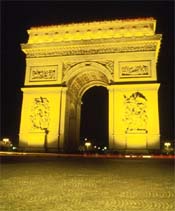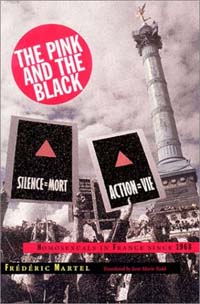 |
|
Homosexuals in France Since 1968 New York University The Pink and the Black: Homosexuals in France Since 1968, by Frédéric Martel, translated by Jane Marie Todd, Stanford University Press, 1996, 442 pages, $19.95
A French audience might have a slightly different reaction to the joke. They might question the use of France to symbolize homosexual identity in the United States and return the imagery. Just as the mention of unconventional sex brings France to the forefront of many American minds, so too in France does evoking gay and lesbian issues set off debates over the "American model." In our age of globalization, these divergent meanings coming from different countries may temper enthusiasm for transnationalism, illustrating as they do the endurance and tenacity of national stereotypes and borders, symbolic or otherwise. They are also a reminder that a good way to gain insight into one "culture" is through the images it creates of "other cultures." This is particularly useful in reading Frédéric Martel's The Pink and the Black: Homosexuals in France Since 1968; while the book is mainly about France, the "American model" plays a strong supporting role. Released in France in 1996, the book made quite a stir in gay and non-gay circles alike. It contributed to continuing debates over the French state's capacity to integrate groups of potentially disruptive "others." Concerns over the arrival in France of what is commonly described as American-style multi-culturalism are primarily associated with the integration of French youth of North-African and sub-Saharan African descent. These worries have recently settled on France's gay and lesbian movement. Raising the specter of American cultural hegemony, Martel joins many in France, on the Left and the Right, who condemn the infliction of divisive Americanized identity movements of which the gay movement, with its nascent "community centers" and "pride marches," has become a prime example. Martel's trump card is that he himself is gay. He hopes the affiliation will strengthen his plea for French gays to reject the American model of celebrating difference. Martel makes this very clear from the start of the book. Having stated his ambitious goal of covering both the gay male and lesbian movements in France from 1968 through an "overview of individual life stories" which "shed light on the sociohistorical dimensions of homosexuality" (7), Martel sets himself up for an impossible task. On the one hand, he wants to produce a serious and unbiased work, announcing his need to be extremely vigilant, to "assert total independence, to cast a critical gaze and maintain distance even with respect to 'homosexual discourse'" (8). On the other hand, he doesn't bother to ponder his own penchant for "universalist" discourses, and in the next paragraph, he jumps into the communitarian versus universalist debate, siding unequivocally with the universalists: he will "show a preference ... for universalism over multiculturalism, for French-style integration over communitarianism, for the 'right to indifference,' the right to be left alone, over the 'right to difference'" (9). Fortunately for us, Martel doesn't get bogged down in this tired debate until halfway through the book, and the early chapters are quite fun reading. From the late 1960s and throughout the 1970s, we witness the unfolding of a radical French gay movement, led by such seductive characters as Guy Hocquengheim and his FHAR (Homosexual Front of Revolutionary Action) and the decline of André Baudry's conservative homophile movement, Arcadie. The 1980s begin on a rosy note with President Mitterrand's arrival and his fulfilled promise to decriminalize completely homosexuality. In the early to mid-1980's, a depoliticized "gay lifestyle" emerges at the same time that public acceptance seems to rise, and French gays and lesbians appear headed towards full social integration. Then AIDS arrives and with it, American-style identity-based activism - throwing off course this romantic tale of French organic solidarity. Before tearing apart this obviously flawed account, we should first give Martel his due. It is astonishing that in France, the source of so many gay icons, barely anything other than Jacques Girard's tiny Le Mouvement homosexuel en France (1981) existed on the movement until Martel's book. And even if it does at times have a tabloid-like feel to it, his narrative reads well and the depth of his research is impressive. He reports having conducted 280 oral interviews for the book, including ones with legendary folks from the French gay movement like Baudry, Jacky Fougeray, and Rene Schérer, well-known gay writers like Edmund White and Yves Navarre, and leading political and intellectual figures, from Jack Lang to Alain Tourraine. Martel also includes a comparatively extensive bibliography for research on homosexuality in France.
Martel's story really falls apart when he begins assigning blame for France's late and inefficient fight against AIDS. According to him, most at fault appear to be the gay activists of the mid-1980s, primarily those who downplayed the crisis, hoping that the initial reports of the epidemic were little more than exaggerated anti-gay propaganda. "'Homosexual denial' is an important fact in the history of the epidemic in France, and the fear of being stigmatized yet again is not an adequate justification for the irresponsibility of homosexual militants" (210). Hellbent on proving that French-style universal integration is superior to American-style community-based politics, Martel attributes this denial to the militants' fixation on their "gay identity" and their "irrational" fear of a homophobic backlash: It is significant ... that all the entitites that were based on a gay identity ... and that claimed to be protecting homosexuals from society, paradoxically - or, perhaps we should say, tragically - deceived homosexuals about the reality of the epidemic that was menacing them ... [w]e must never forget that fear of homophobia, a recurrent obsession among homosexual militants, cruelly masked the disease and considerably delayed the moment when people took stock of it (350). The arrival and imposition of an Americanized "gay identity" is seen as a direct result of AIDS, and both are portrayed as external intrusions, disrupting what would otherwise have been a peaceful, almost natural integration: "The aggressiveness of the virus alone allows us to understand this [identity] movement: without AIDS, the French model of assimilation (whereby society integrates individuals but does not recognize groups) probably would have prevailed over the American communitarian model" (353).
 These are patently specious and malicious words to write in 1996, and Martel seems blinded by his ideology throughout his account of the AIDS epidemic in France. If during the early to mid-1980's French gays were well on their way to full and undifferentiated integration into the republic, why did France's universal health system fail them so miserably in addressing the epidemic?
These are patently specious and malicious words to write in 1996, and Martel seems blinded by his ideology throughout his account of the AIDS epidemic in France. If during the early to mid-1980's French gays were well on their way to full and undifferentiated integration into the republic, why did France's universal health system fail them so miserably in addressing the epidemic?
If, as he contends, French gay activists and associations wielded little influence and had only a tiny following by the mid-1980's, how can we hold them responsible for not getting out the prevention message? And if the "French way of integrating individuals" is so radically different - and superior - to the American model of trapping people in "communities," why even worry about it? Indeed, if the French model of integration is so successful, why would French gays or members of other groups in France feel any attraction for "American-style multiculturalism"? A more historical and less polemical assessment of the spread of AIDS in France would have, of course, included a sensitive and in-depth discussion of the medical uncertainties of the early 1980s and the subsequent failings of the French state over the rest of the decade to recognize the threat and effectively pass that information on to gay men. But it would also have deprived us of a wonderful primary source that documents France's ongoing struggle to deal with cultural diversity. Review from the International Gay & Lesbian Review, ONE Institute Press, Los Angeles, CA |


 In the movie But I'm a Cheerleader, the teenagers at a gay-to-straight rehab center must pinpoint the "root" of their homosexuality. One adolescent girl reports that her mom got married in a suit, while a teenage boy frets over an excessively close relationship with his mother. When another girl responds, "I was born in France," the characters in the film nod their heads in unison while the audience chuckles. American stereotypical reference to France efficiently signifies here things sexually deviant, perverse, morally loose at least.
In the movie But I'm a Cheerleader, the teenagers at a gay-to-straight rehab center must pinpoint the "root" of their homosexuality. One adolescent girl reports that her mom got married in a suit, while a teenage boy frets over an excessively close relationship with his mother. When another girl responds, "I was born in France," the characters in the film nod their heads in unison while the audience chuckles. American stereotypical reference to France efficiently signifies here things sexually deviant, perverse, morally loose at least.